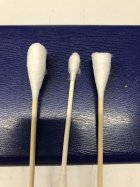I'll only say this...I doubt there is another tuner on the market that has 1% of the national titles and records that mine has set. There's a reason for that kinda stat. It's not an accident. It took a lot of hours(years) and a lot of testing, both in matches and in labs doing vibration analysis testing to learn about what is actually happening with tuners. And yes, they basically all work on the same principle. Mine has features that have since been copied by others( a few others). Ultimately, that's a move toward advancing accuracy, though. I'm for that!
Mine isn't a simple mass but it'd be a lot cheaper to make if it were. After hours of testing many different designs and dampening means, I do make them the way I do because I DO believe it's the best that can be made.
I have no reason to talk down any other product and I DO NOT! But I do believe that mine has a record to stand on that will be hard to ever surpass. It's simply a good and well engineered tuner with support to back it up. It's record speaks for me but I'm always here to help.
For years, the thing holding tuners back, was the lack of someone that had deciphered how to make a tuner work best for the shooter. They always worked but the support behind them was lacking. Results speak clearly but so does the lab testing that allows us to utilize them most efficiently. The most common mistake is moving a tuner too far at a time. A few years ago, there used to be lots of misleading info in that regard and every maker seemed to be drastically different from one another.
The real secret is in using most any tuner to its potential.
If you do that, they can all tune a rifle. Tuning it to shoot small is the easy part. The real trick is in knowing what to do and why, when it goes out of tune.
I only do tuner orders by phone because of this and the method that I've found best to establish a good tune, I can cover in detail while answering questions and going into detail as to why. This method involves a test that shows so much info that you really do need to know to understand why groups form the way they do, repeatably and consistently. One thing that comes to mind is that with my tuners, there is a point when groups stairstep up and to the right. Well, from a rh twist bbl, physics says that's not wind but it happens when out of tune. This is just one example. It's a 20 minute conversation and I do the best I can to explain why things like that happen and how to correct it when it does. That is all... and thank you all very much!l!!--Mike Ezell
Mine isn't a simple mass but it'd be a lot cheaper to make if it were. After hours of testing many different designs and dampening means, I do make them the way I do because I DO believe it's the best that can be made.
I have no reason to talk down any other product and I DO NOT! But I do believe that mine has a record to stand on that will be hard to ever surpass. It's simply a good and well engineered tuner with support to back it up. It's record speaks for me but I'm always here to help.
For years, the thing holding tuners back, was the lack of someone that had deciphered how to make a tuner work best for the shooter. They always worked but the support behind them was lacking. Results speak clearly but so does the lab testing that allows us to utilize them most efficiently. The most common mistake is moving a tuner too far at a time. A few years ago, there used to be lots of misleading info in that regard and every maker seemed to be drastically different from one another.
The real secret is in using most any tuner to its potential.
If you do that, they can all tune a rifle. Tuning it to shoot small is the easy part. The real trick is in knowing what to do and why, when it goes out of tune.
I only do tuner orders by phone because of this and the method that I've found best to establish a good tune, I can cover in detail while answering questions and going into detail as to why. This method involves a test that shows so much info that you really do need to know to understand why groups form the way they do, repeatably and consistently. One thing that comes to mind is that with my tuners, there is a point when groups stairstep up and to the right. Well, from a rh twist bbl, physics says that's not wind but it happens when out of tune. This is just one example. It's a 20 minute conversation and I do the best I can to explain why things like that happen and how to correct it when it does. That is all... and thank you all very much!l!!--Mike Ezell
Last edited:













